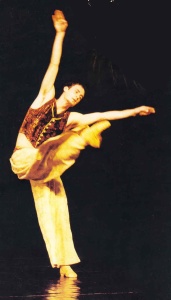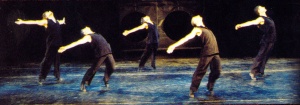Purim: The Casting of Fate, Gyor National Ballet Theater
The Gyor National Ballet Theater of Hungary production of Purim: The Casting of Fate, presented at the Joyce Theater in Manhattan, is a powerful retelling of Megillas Esther transformed into dance. This modern ballet, fueled by a musical score by Ferenc Javori, the founder of the Budapest Klezmer Band, pulsates with energy and joy. It is a successful combination of vibrant klezmer music, striking set and lighting design, evocative costumes and sensitive choreography. The staging artfully combines abstract dance idioms and more concrete devices of props and pantomime. The music advances the narrative and powerfully shifts the mood from delicate klezmer ballads to rousing ensemble compositions redolent of Central European Jewish life. Underlying it all is a striking modern dance score.
The curtain rises on a lone Jew dancing lovingly around a dusty trunk. He removes an ancient scroll and unrolls it before us. A young female dancer appears and scoops up the scroll and disappears. In the background looms the abstract form of a scaffold. Out of the darkness we make out a symmetrical pair of steps up to a high platform.

Suddenly the stage explodes with passionate klezmer music and a corps of dancers evoking the textures and images of King Achashverosh’s Persian court and its pagan wine banquet. The young king resplendent in a long brocaded vest atop billowy Persian-style pants surveys the festivities from stage right. Vashti, in a flimsy white shift demarcated by a bold black pattern, admires herself before a mirror to the left. The clumsy plotters Bigtham and Teresh cavort in heavy jackets as Haman, simply attired with a lone dagger in his waistband, looms in the center. As the characters emerge we slowly recognize the classic Purim tale that has been altered, molded and simplified to suit the specific purpose of librettist, Robert ben Turan.
Soon the scene shifts to the Jews, outfitted in subtle costumes of dark browns and blacks with a hint of stripes on the backs of their jackets. Nothing obvious would identify them as Jews except certain steps and subtle hand motions that characterize a more sensitive and passionate people. Mordechai strides on stage confidently, each step conveys strength of leadership, and his close and tender relationship with his niece, Esther.
The first act continues with a violent gang war between the Jews and Haman’s henchmen. This is followed by a delicate and touching duet between Mordechai and Esther. Each attempts to understand this eruption of anti-Semitism. The duet is punctuated by the music of two musicians who intertwine gracefully with the dancers. Throughout the ballet the Budapest Klezmer Band is always on stage. Perched above on the scaffold, they occasionally interact with the dancers or lurk center stage in doorways. As the confrontation escalates Haman’s arrogance swells and all are forced to bow in deference to his power. Mordechai refuses. Haman’s fury is reflected in a crescendo of music and frantic dancing. The pur is cast. The Jews are condemned to death. On the scaffold above an enormous noose appears, and the first act ends.

The second act begins with a silent dance. Out of the darkness we hear a voice, pleading, “Purim, purim…” as the mournful Jews grope, dance and struggle with the deathly decree. The music rises and drives the dancers in an abstract evocation of incomprehension. Noticeable in the darkness above is a firmament of stars. An angel appears. She comforts the Jews and intertwines with the dancers until each slips away, leaving Esther alone with her people’s fate. The angel has inspired Esther. Esther must save her people. She must return to the king. The ballet moves forward with the touching courtship of Achashverosh and Esther and the Queen’s regal coronation. The power struggle between Esther and Mordechai, and Haman is sketched in a powerful manipulation of dancers slashing across the stage in symbolic narrative. The noose reappears as Esther now pleads with the King for the life of her people. Suddenly the stage is invaded by twenty black robed specters, inquisitors that will seal Haman’s fate as he is accused by Esther and condemned by the King. The drama tightens as Haman, pleading for his life, is marched up the stairs of the scaffold. With the noose placed around his neck, the lights descend, the music climaxes, he is hanged. We gasp.
A silent epilogue follows. Again under the stars, the Jews reappear in a tender dance of mourning for all past persecutions and oppression. Slowly but confidently they join the now joyous music as the King, Esther and Mordechai celebrate in the triumph over the evil Haman. This production of Purim, shaped by the librettist Robert ben Turan and brought to life by choreographers William Fomin and Istvan Juhos and vitalized by the music of Ferenc Javori, has taken apart the Megillah and reassembled it. These Jews worked with the non-Jewish Gyor National Ballet and the expert director, Janos Kiss to recast the Purim story into a universalist vision. “The evil wanted to damn the truthful, but the foul has fallen into the hands of the innocent.” This vision is especially potent for Jews and non-Jews in Hungary still mindful of the communist oppression that ended barely ten years ago.
The ballet Purim, using the abstract medium of modern dance and uniquely Jewish Klezmer music that at times transcends its identity, opens the story of Esther in our Megillah to the rest of the modern world. It spreads the message that through one woman’s bravery and self-sacrifice the oppression of a people can be overcome. Over the past three years this production has been performed to enthusiastic audiences over eighty times in Hungary, Holland, Denmark and Slovakia. Most importantly, contemporary dance has been transformed into a medium for the exploration of biblical art.
Finally the lone Jew reappears on stage in a final coda. He collects the ancient scroll and, in a slow and thoughtful dance to the haunting strains of a violin, cradles it lovingly and stores it away in the old trunk, perhaps for next year.